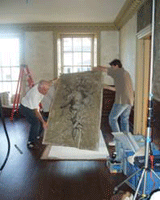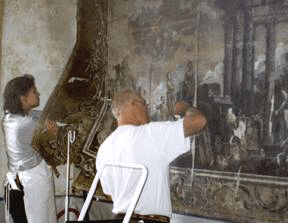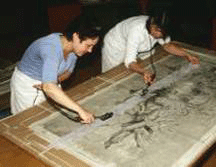October 2005 – June 2006
Conservation and preservation of original 18th-century English wallpapers that remarkably survive in place in the Lee Mansion was accomplished in 2005-6, thanks to two grant awards from the National Endowment for the Arts Save America’s Treasures program, matched by the Getty Foundation. The 4 sections of the hand-painted mural papers will serve as a pilot project for the rest of the stair-hall papers which will need to be removed, treated and lined once sufficient funding is secured. $500,000 in additional grants will be required.
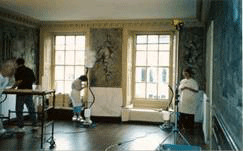
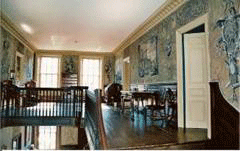 The work was accomplished over nine months by five conservators with Studio TKM of Somerville, Massachusetts, one of the best qualified conservation teams anywhere. They removed and treated four panels of the rare hand-painted mural papers in the second-floor stair-hall. More of those papers will need to be conserved at a later date, pending additional funding.
The work was accomplished over nine months by five conservators with Studio TKM of Somerville, Massachusetts, one of the best qualified conservation teams anywhere. They removed and treated four panels of the rare hand-painted mural papers in the second-floor stair-hall. More of those papers will need to be conserved at a later date, pending additional funding.
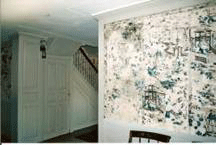
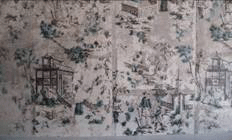 On the third floor, block-printed wallpapers with delightful Chinese scenes were also conserved. The latter are very rare in their own right, since they are the only English ‘Chinoiserie’ wallpapers in either America, or apparently England as well, to survive on the walls of their original home.
On the third floor, block-printed wallpapers with delightful Chinese scenes were also conserved. The latter are very rare in their own right, since they are the only English ‘Chinoiserie’ wallpapers in either America, or apparently England as well, to survive on the walls of their original home.
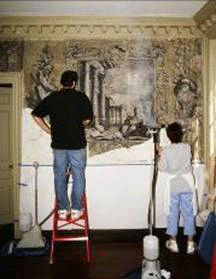
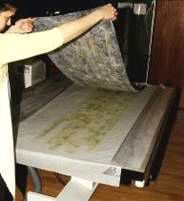
The fragile papers were carefully removed from the original plaster walls using steam, moisture, and delicate tools such as scalpels. They were then transported to a studio near Boston.
The surface pigments were stabilized with a gel consolidant, and tears were carefully mended using Japanese paper, heat, and special adhesives. The papers were also reinforced by lining them with non-tearable Japanese paper using wheat starch paste In-painting (painting small areas by the conservators to match the original design) was done to small areas of paint or paper loss.
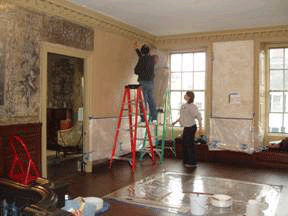 To more safely secure the 18th-century papers to the walls and to facilitate more effective adherence, the original plaster walls were also lined with paper, and also with a layer of fabric as a buffer.
To more safely secure the 18th-century papers to the walls and to facilitate more effective adherence, the original plaster walls were also lined with paper, and also with a layer of fabric as a buffer.
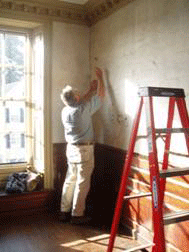
Before the walls were lined, the plaster was inspected by Andrew Ladygo, a national authority on historic plaster from Manchester, Massachusetts, who has worked at many historic sites around the country, including the U.S. Capitol. The plaster was in sound condition.
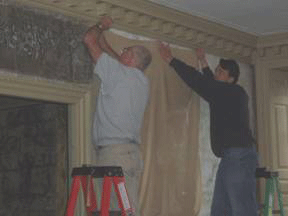
Now, the fragile original papers are no longer in contact with the original plaster, which responds to the climate differently than the 238-year-old linen-based wallpaper.
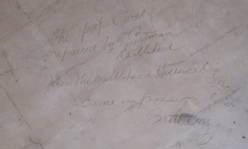 Under the wallpapers in both locations, several inscriptions written in pencil on the plaster were discovered. On the second floor (on wall pictured at left), Thomas Pitman of Marblehead documented repairs he undertook in 1909, “when the Historical Society came into possession of the building.”
Under the wallpapers in both locations, several inscriptions written in pencil on the plaster were discovered. On the second floor (on wall pictured at left), Thomas Pitman of Marblehead documented repairs he undertook in 1909, “when the Historical Society came into possession of the building.”
Removal of the block-printed Chinoiserie wall-papers on the third floor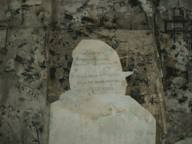 revealed a humorous hand-written notation by someone else, probably sometime in the 1800s: “ ~ Notice – Some vandal cut this / figure out and carried it off. / Be kind enough not to follow his or her mean example.”
revealed a humorous hand-written notation by someone else, probably sometime in the 1800s: “ ~ Notice – Some vandal cut this / figure out and carried it off. / Be kind enough not to follow his or her mean example.”
This project was made possible by a federal grant from Endowment for the Arts through the Save America’s Treasures program, matched by the Getty Grant Program of the Getty Foundation near Los Angeles.


